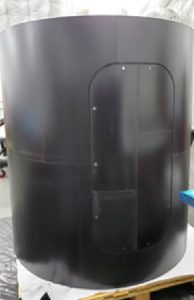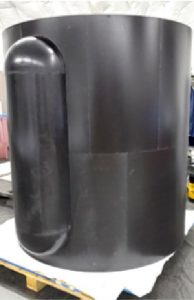Thermal Protection Systems
Overview
Faraday® Thermal Protection Systems were initially designed to protect boost vehicles from both extreme temperatures and lightning threats. Over the years, this system has become a bespoke shielding solution for a variety of applications. Faraday’s unique design allows it to be custom-tailored to fit your specific needs. Its all-carbon design provides exceptional thermal and environmental stability, while also protecting your vehicle from a diverse range of threats, including:
Overview
Faraday TPS introduces an innovative layered approach to the industry that allows for complete customization to meet customer needs. Individual layers can be added, removed, or altered independently from each other to meet each application’s specific threat profile for a truly SWAP-C optimized system.
The Faraday system can be fit to a variety of complex geometries across a range of sizes from small, tactical applications to large boost vehicles.
The article shown below has an inner diameter just over 54 inches (1.37 meters) and is 5 feet (1.52 meters) tall with customized additions that show the ability of the Faraday TPS system to deal with protrusions and access ports from the fuselage surface.
RESEARCH & DEVELOPMENT AREAS OF EXPERTISE
- Aircraft R&D
- Aluminum Research
- Carbons R&D
- CMC & MMC Materials Development
- Coal Product Development
- Composites Structure Development
- Exhaust Systems Development
- Thermal Protection Systems
- SBIR/STR Subcontracts/Partners
- Steel Products Development
- Intellectual Property to License
The above video shows a standard TPS panel going through aero testing.
Testing
Faraday systems have survived a grueling testing regimen involving lighting strikes up to 200kA, aerothermal testing up to 1093°C (2000°F) at Mach 4, and extensive environmental stability tests per MIL-STD-810H.
To simulate a representative mission profile, Touchstone exposed panels to a simulated launch environment. Then, those same panels were sent for lightning strike testing. And finally, they were tested in a hot gas flow chamber to simulate various aero loads. These panels performed their duty despite this abuse.
History
Since the 1990’s when Touchstone assisted NASA’s Marshall Space Flight Center in the development of the MCC-1 TPS for the Space Shuttle’s Solid Rocket Booster, Touchstone has been researching and developing novel concepts for next-generation thermal protection systems for rockets.
Touchstone has developed both ablative and non-ablative TPS systems. Amongst the materials used in the designs are CFOAM carbon foam, carbon aerogels, Silicon Carbide, carbon-carbon, cork, glass beads, and more. Touchstone has also provided an array of thermomechanical testing for both metallic and non-metallic thermal protection systems.

CFOAM
Carbon Foam

Carbon
Aerogels

Silicon
Carbide

Carbon-Carbon

Cork

Glass Beads








